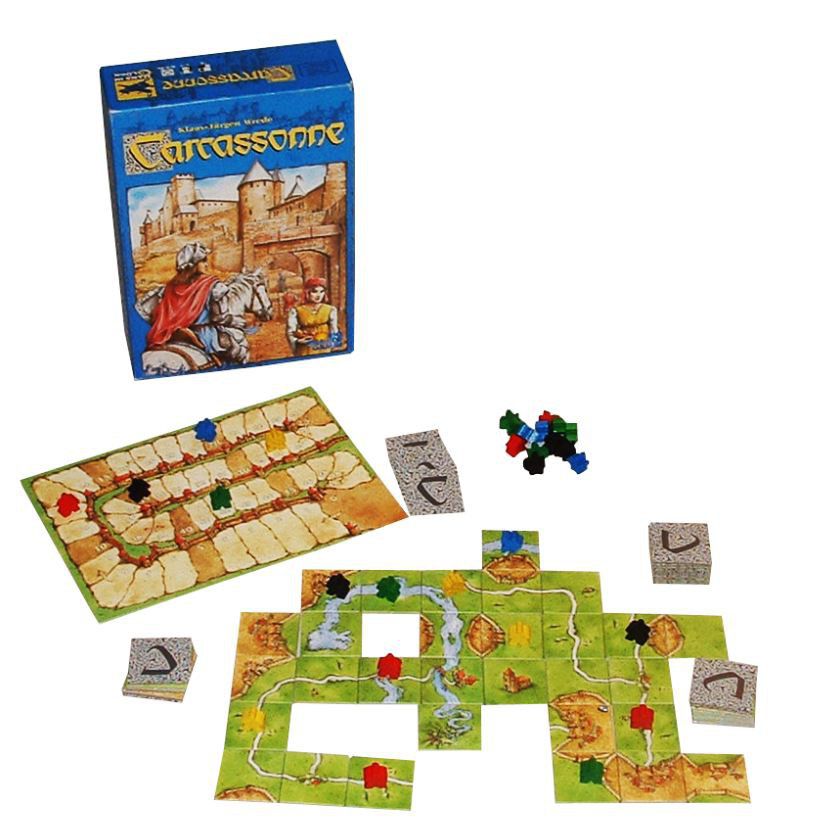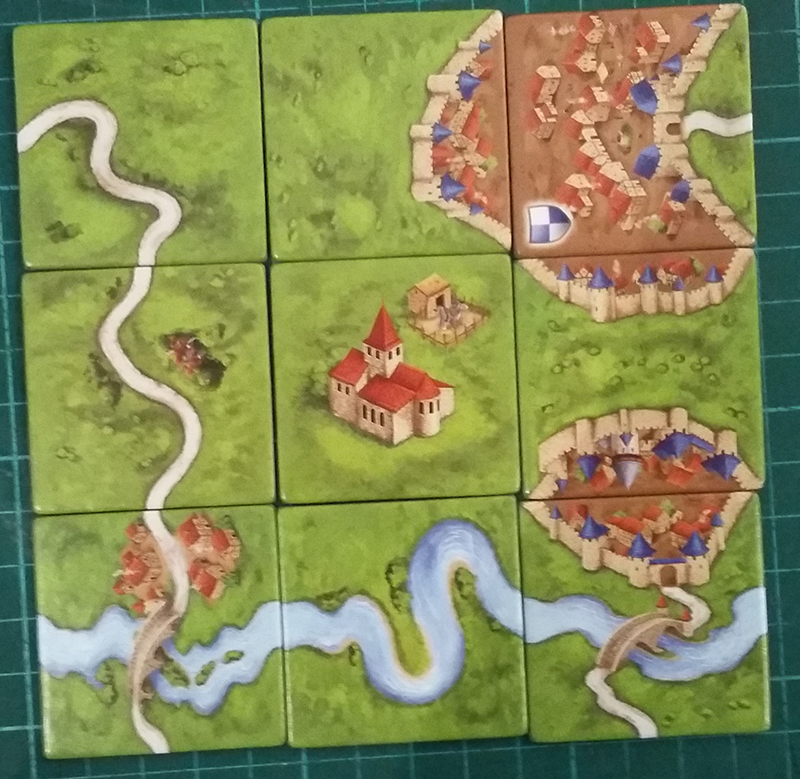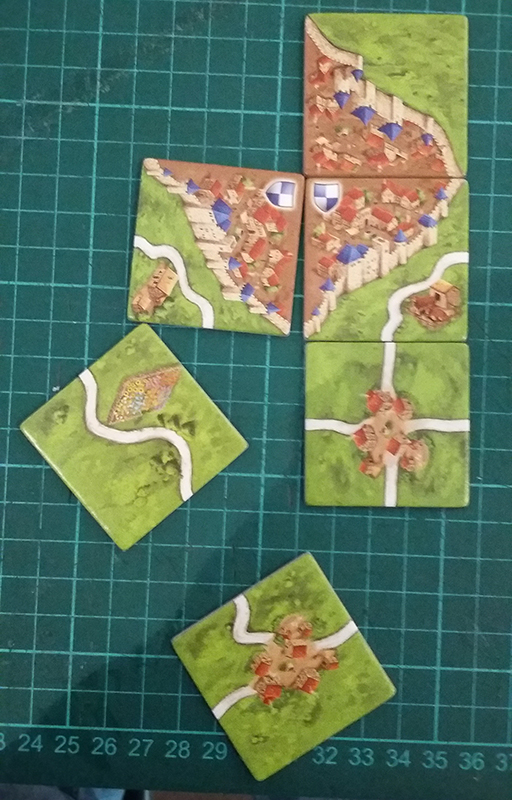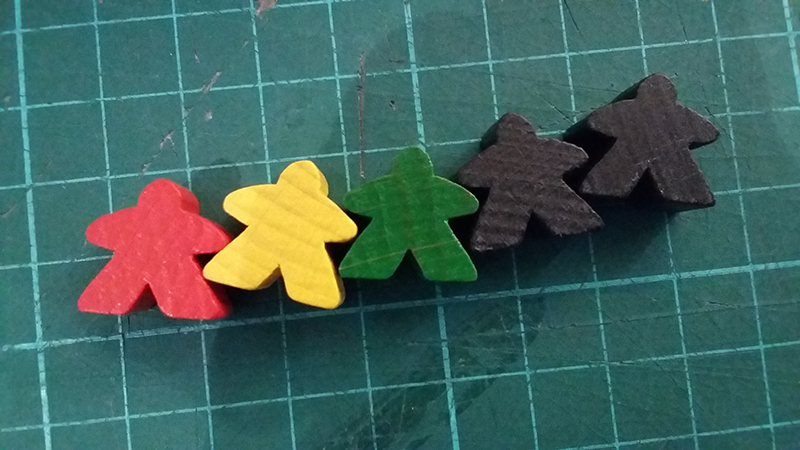Carcassonne – Visual Accessibility Analysis
Carcassonne is a tile laying game that is a staple of many a game collection. But how accessible is it to people who’re blind and vision impaired?
Introduction
You don’t have to spend long playing modern board games before you come across Carcassonne. This fantastically popular tile laying game is one of the early entries on the scene and remains a perennial favourite adorning many a shelf and frequently recommended as a “must have” for any collection.
If you’ve not played it though, as someone who is blind or vision impaired, you may be wondering how well you might be able to play it. Alternatively, if you’re looking to introduce the game to such a person you may wonder likewise for them. Well you’re in luck, for in this post I will consider the question how accessible is Carcassonne?
Game Overview
 Image showing the game components of Carcassonne
Image showing the game components of Carcassonne
-
Game name: **Carcassonne
-
Publisher: Hans Im Glück
-
Player count: 2-5
-
Playing time: 30-45 minutes
In Carcassonne players take turns drawing tiles and placing them on the table to form the city and its surrounds. They will place their limited supply of meeples on features on these tiles, scoring and removing the meeple when the feature is complete. The game ends when all tiles have been placed, and the winner is the player with the highest score.
To set up the game the starting tile is set aside while all tiles will be shuffled, face down, arranged into stacks, and placed in easy access. The base game comes with an expansion, the river, and if using that expansion those tiles are shuffled separately and drawn from first.
Players then take turns drawing and placing tiles. Tiles are drawn from any stack (once the river tiles are finished, if in use) and must be placed adjacent an existing tile so that the features on the tile match up. Tiles may contain a mixture of features which include:
-
City sections (brown walled sections with small buildings)
-
Fields (green expanses)
-
Monasteries (churches)
-
Road sections (yellowy snaky lines)
 Image showing the various tile features. From top left to bottom right: road; city; city with road; road; monastery; city; road and river; river; city, road, and river.
Image showing the various tile features. From top left to bottom right: road; city; city with road; road; monastery; city; road and river; river; city, road, and river.
The second edition also includes a new feature, the garden, which consists of a flower bed.
The only placement rules for tiles, as mentioned, is that features match up. Roads can only connect to other roads, city sections to other city sections, and fields to more field.

Image shows a tile placement example. The straight road can’t be placed in the bottom left corner, but the intersection can be.
Once the tile is placed, the player placing the tile has the option of placing one of their meeples on one of the features present on the tile, thus claiming the feature. Meeples remain on features until scored, and a player’s supply of meeples is limited so they are a resource to be managed carefully. In the second edition of the game, each player has seven meeples (plus one which is placed on the score tracker) and an abbot meeple. The game’s various expansions add other meeples, such as the builder, and the pig.
Meeples placed in cities are knights; on fields, farmers; in monasteries or gardens, monks, and on roads, bandits. The abbot meeple can only be placed in a monastery or garden, but unlike other meeples may be removed prior to the monastery or garden being finished, instead of placing a meeple that turn, scoring partial points for the monastery or garden he was on.
Once a player decides whether or not to place a meeple, any completed feature is scored:
-
Cities are completed when they are completely walled in and their interior filled with city tiles. They score two points per tile, and two points per pennant (blue and white check shields) on each tile.
-
Gardens and monasteries are completed when the eight tiles around the garden or monastery are all placed. They score nine points, or in the case of an abbot that is removed early, one point per tile (including the garden and monastery itself)
-
Roads are complete when the road terminates at both ends. Termination points include intersections, monasteries, and cities. They score one point per tile.
Fields are unique in that they are only scored at the end of the game. They score three points per completed city they border.
When placing meeples there is only one rule, which is that meeples cannot be placed on a feature which already has a meeple on it. For example, if you extend a road on which you or your opponent have already placed a meeple, you cannot place a meeple on that road.
There are however ways to place meeples on a feature then join it up to another feature on which a meeple has already been placed. In such instances points are shared in cases where multiple players have the same number of meeples on a completed feature, otherwise they go to the player who has the most meeples on a feature.
Tricksy meeple placement can be particularly prevalent when claiming fields!
Once the last tile is placed, players score their incomplete features (every tile in the relevant feature is worth one points, ditto pennants in cities), and then their farms. The highest score wins the game.
Visual Accessibility
At this point you likely have some questions and serious doubts regarding the accessibility of Carcassonne. How can I tell what features are on a tile? How am I going to distinguish features on tiles that’ve already been placed? How can I stop knocking meeples over and sending tiles a-scattering?
These questions and concerns are all well founded. The playability of the game however is quite different depending on the level of sight the player has remaining.
Vision Impaired
Carcassonne is a very visual game and your ability to play and enjoy the game is going to vary dramatically depending on the peculiarities of your own condition. That said, the one big positive about Carcassonne for players with vision impairment is the absence of hidden information.
All information in Carcassonne is public information from the moment you turn over the tile you have selected from the stack. As a result, your fellow players or any observer can assist you identify features on your tile and select a suitable and beneficial location to place said tile.
If you doubt the credibility of advice from your opponents, there’s nothing to say you cannot play Carcassonne as a team game. Players could either divide into teams with equal player numbers sharing a single pool of meeples, or each member of the team could have their own set of meeples. It doesn’t really matter, the point is that there is nothing stopping you playing the game that way and leveraging the sight of your teammate or other players to assist in identifying features and interpreting the lay of the land (or tiles in this case).
With regard to identifying tile features unaided, there are two things to discuss. The first is the tile state. Tiles are either face down in the stack, in your hand awaiting placement, or placed on the table.
When interacting with tiles in the first state (i.e. drawing a tile) you simply need to know where the stack is. There are no real boundaries there. Once a tile is drawn, it will be much easier to determine the features of a tile in your hand than one already placed. There are a couple of strategies you could use here, other than advice from fellow players as already mentioned, to overcome this challenge.
The first is playing the memory game. Do your best to keep track of what you’re placing and where. This need only be as simple as “I have a meeple on a road/city/monastery that I want to finish”. If you can keep track of what sort of tiles you want for the feature your meeple is on (e.g. you have a meeple on a city, and you keep in mind that you want a one sided city piece to finish it off) that’s even better.
The second strategy is to photograph with game state with your phone so you can bring it closer and enlarge it. While this may slow down gameplay, I know it is a simple and common approach to overcoming the challenge of interpreting the state of play.
With regard to the visual aspects of the tiles themselves, the colour pallet isn’t bad, but it isn’t good either. Distinguishing cities, roads, and monasteries is fairly straight forward. The contrast is adequate, further features are placed consistently in that how and where they appear on tiles is always the same: monasteries are always in the centre; roads exit from the centres of the edges; cities span one or more edges of a tile.
The features that are harder to distinguish are gardens and the river. For the river, this isn’t much of an issue as those tiles are always placed first and every tile in the river stack has a section of river on it. Gardens on the other hand are much more difficult. Gardens tend to blend into fields. They also can be confused with non-scoring aesthetic features that appear in fields. As a result, I frequently place gardens without realising they’re on the tile, missing an opportunity to place a meeple on the garden. As I have said though, all information is public information, and you can always get assistance to identify potential gardens.
Finally we come to the playing pieces: the meeples and the score track. The meeples suffer the common problem that certain colours are very hard to tell apart, namely green and blue but the black meeples can be difficult to tell from the blue ones too. Ultimately this isn’t a problem if you’re only playing with two or three players. Alternatively of course it isn’t difficult to paint or replace meeples with ones that have a better suite of contrasting colours.
 Image showing Carcassonne’s meeples. It looks like I’m about to dissect them on my cutting mat, but I assure you no meeples were harmed in the writing of this article.
Image showing Carcassonne’s meeples. It looks like I’m about to dissect them on my cutting mat, but I assure you no meeples were harmed in the writing of this article.
Finally, the score track can be a little difficult to interpret I find. This is a function of the thin lines separating each number. Each fifth square is shaded though, so that’s nice.
Ultimately though your experience is going to differ based on your own circumstances and abilities.
Totally Blind
Unfortunately for totally blind players the contrast of features of the tiles won’t make any difference. Further, while a lack of hidden information is good, when a player is totally blind the result will simply be other players playing the game for them.
I do think however that an accessible version of Carcassonne could be developed. Full accessibility could be achieved by adding a tactile element to the game. You might even be able to do it at home yourself, though I’m talking about a pretty heavy level of modification.
The first step would be developing a tactile surface for tiles that enabled a player to easily tell the difference between the different features. There aren’t that many features on tiles (two or three, depending whether you consider field a tile feature). Basic raised geometry would suffice for roads, monasteries, and gardens, and for cities raised lines for the wall line and a different surface for the interior of the city.
The second step would be more complex. To avoid tiles and meeples being sent flying while a blind player feels those that have been placed, it would be desirable to either increase the weight of playing pieces or better yet magnetise them. This process would be more complicated and expensive, but I think it would be possible.
I see no reason why both these modifications couldn’t be made without impacting the visual elements of the tile. Meaning that sighted assistance in addition to the tactile elements would still be possible.
This solution to improve to make Carcassonne fully accessible is of course completely theoretical. While I do think it is possible, until then the game is unfortunately not accessible for people who are blind.
Conclusion
Carcassonne is a thoroughly enjoyable game, but it is a game where vision plays a big role in your ability to play the game. Depending on your level of vision impairment, good lighting, helpful players, and your phone camera may be more than enough for you to play and enjoy the game.
For people with more significant levels of vision impairment or who are totally blind however the game is not accessible. Though I think it is theoretically possible to modify the game to add a tactile element to it, such modification would be pretty extensive and you’d likely need to be quite dedicated to undertake the task.
Finally, I didn’t have a place to say as much, but I have a minor gripe about the second edition unrelated to accessibility. The game doesn’t come with the 50/100 tiles that the first edition did. These tiles were awarded for players who had travelled around the score track (which goes from 0 to 49), showing 50 on one side and 100 on the other. I think they were a help keeping track of score so it is a shame they omitted them.
Leave a comment